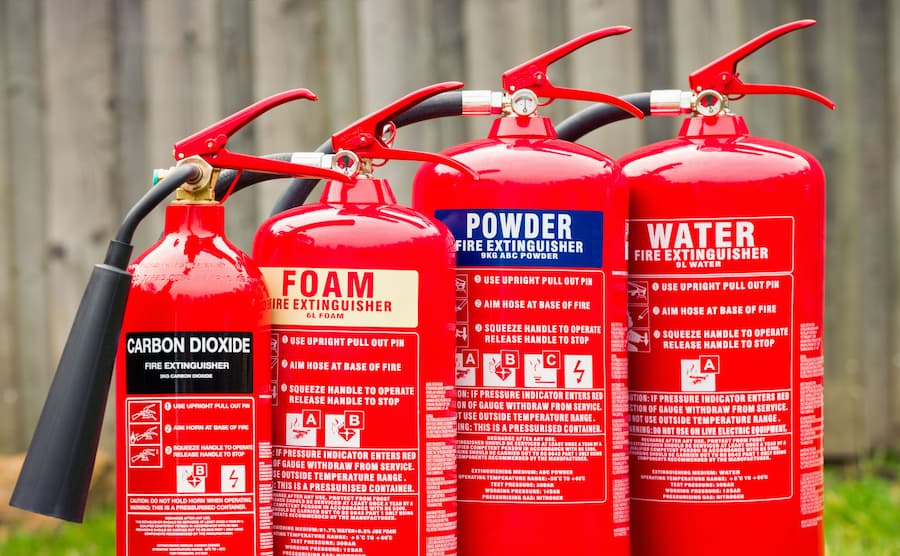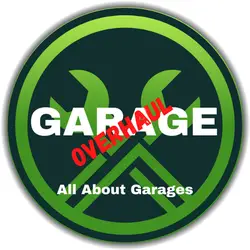Should I Have A Fire Extinguisher In My Garage?
This post contains affiliate links.
When it comes to home safety, having a fire extinguisher is a must. It can help put out small fires before they turn into major disasters. However, many people often overlook the importance of having a fire extinguisher in their garage.
With flammable liquids & materials, gasoline, and propane tanks typically stored in garages, the risk of a fire starting in this area is high. Having a fire extinguisher in the garage is essential and recommended.
So, the question remains: should you have a fire extinguisher in your garage? The answer is not a straightforward one. There are various factors to consider, such as your garage type, what you store in it, and the potential fire hazards in your area. In this article, we will explore the importance of having a fire extinguisher in your garage and help you determine if it is necessary for your situation.

Assessing the Risks: What Hazards Are Present in Your Garage?
Assessing the risks is crucial in determining whether you need a fire extinguisher in your garage. Here are some of the hazards that are commonly present in garages:
- Flammable liquids: Gasoline, oil, paint thinners, and other flammable liquids are often stored in garages and, if not handled properly, can cause a fire.
- Propane tanks: Many homeowners store propane tanks in their garages, which can pose a significant fire hazard if not properly maintained.
- Electrical hazards: Faulty wiring, overloaded circuits, and exposed wires can contribute to garage fires.
- Combustible materials: Paper, cardboard, and other combustible materials are often stored in garages and, if not disposed of properly, can fuel a fire.
- Vehicles: Vehicles are also a potential fire hazard, as they contain flammable fluids and are often parked near combustible materials.
Read more about garage dangers and safety hazards here.
By identifying the hazards in your garage, you can determine whether a fire extinguisher is necessary and take steps to minimize the risk of a fire starting in the first place.
Garage Fire Statistics: Why You Can’t Afford to Ignore the Risks
Garage fires are more common than you might think, and the statistics show that the risks are real. Here are some eye-opening statistics that demonstrate why you can’t afford to ignore the risks of garage fires:
- The National Fire Protection Association (NFPA) reports over 6,600 garage fires in the United States in 2019, resulting in 30 deaths, 400 injuries, and nearly $500 million in property damage.
- The NFPA also reports that the leading cause of garage fires is an electrical malfunction, accounting for 24% of all garage fires. Other leading causes include heating equipment, intentional fires, and appliances.
- According to the U.S. Fire Administration, the risk of garage fires is highest during winter, with December and January being the peak months.
- The U.S. Fire Administration also reports that garage fires are more likely to spread to the home than other types of fires due to the garage’s proximity to the living spaces in the home.
These statistics highlight the importance of taking garage fire risks seriously and preventing and preparing for garage fires. A fire extinguisher can help you quickly extinguish a small fire before it becomes a major disaster.
Choosing the Right Fire Extinguisher for Your Garage: What You Need to Know
Choosing the right fire extinguisher for your garage is essential to ensure you can effectively extinguish a fire. Here’s what you need to know when selecting a fire extinguisher for your garage:
- Choose the right class: Fire extinguishers are classified according to the type of fire they can extinguish. Choosing a multipurpose fire extinguisher that is effective against Class A, B, and C fires is recommended for a garage. Class A fires involve ordinary combustibles such as wood, paper, and cloth; Class B fires involve flammable liquids such as gasoline and oil; and Class C fires involve electrical equipment.
- Consider the size: Fire extinguishers come in different sizes, and it’s important to choose one that is appropriate for the size of your garage. A good rule of thumb is to have at least one 10-pound fire extinguisher for every 600 square feet of space.
- Look for certifications: Make sure the fire extinguisher you choose has been tested and certified by a recognized testing agency, such as Underwriters Laboratories (UL) or the National Fire Protection Association (NFPA).
- Check the expiration date: Fire extinguishers have a limited lifespan and should be replaced every 5-15 years, depending on the type. Make sure to check the expiration date of your fire extinguisher and replace it if necessary.
By following these tips, you can choose a fire extinguisher that is effective against the most common types of fires in garages and ensure that it is in good working condition when needed.
Where to Store Your Fire Extinguisher: Tips for Accessibility and Safety
Once you have selected a fire extinguisher for your garage, it’s essential to store it in a location that is easily accessible and safe. Here are some tips on where to store your fire extinguisher:
- Keep it within reach: Store your fire extinguisher in a location easily reachable during a fire. Ideally, it should be mounted on a wall near the garage exit, so you can quickly grab it and evacuate the area.
- Avoid obstructions: Make sure your fire extinguisher is not obstructed by any objects, such as boxes or tools, that could prevent you from accessing it quickly.
- Use a fire extinguisher bracket: Mount your fire extinguisher on a specifically designed bracket. This will keep it secure and prevent it from falling or tipping over.
- Avoid extreme temperatures: Fire extinguishers should be stored in a location not subject to extreme temperatures. Avoid storing them near heat sources or in direct sunlight.
- Check for visibility: Make sure your fire extinguisher is visible and identifiable, with clear signage or labels indicating its location.
By following these tips, you can ensure your fire extinguisher is easily accessible and in good condition when needed. Remember to check your fire extinguisher regularly for any damage or signs of wear, and replace it if necessary.
How to Use a Fire Extinguisher: A Step-by-Step Guide for Garage Fires
Knowing how to use a fire extinguisher correctly can make all the difference in a garage fire. Here is a step-by-step guide on how to use a fire extinguisher for garage fires:
- Pull the pin: The first step is to pull the pin on the fire extinguisher. This will break the seal and allow the extinguisher to discharge.
- Aim at the base of the fire: Aim the extinguisher’s nozzle at the base of the fire rather than the flames themselves. This will help smother the fire at its source.
- Squeeze the handle: Squeeze the handle of the fire extinguisher to release the extinguishing agent. Use a sweeping motion to cover the entire area of the fire.
- Back away: Once the fire has been extinguished, back slowly to avoid reigniting the flames. Continue observing the area for a while to ensure the fire doesn’t rekindle.
- Call for help: If the fire is too large to be extinguished with a fire extinguisher, call for emergency assistance immediately.
Remember, using a fire extinguisher requires quick thinking and action. Familiarize yourself with the instructions and practice using a fire extinguisher before an emergency occurs. By knowing how to use a fire extinguisher, you can help prevent a small fire from turning into a major disaster.
Garage Fire Prevention: Best Practices for Avoiding Common Hazards
Preventing a garage fire is essential to ensure the safety of your home and family. Here are some best practices for avoiding common hazards that can lead to garage fires:
- Store flammable liquids properly: Store flammable liquids, such as gasoline, oil, and paint, in approved containers that are tightly sealed and labeled. Keep them away from heat sources, such as water heaters or furnaces.
- Use electrical equipment safely: Avoid overloading electrical outlets. Never use frayed or damaged cords. Unplug power tools when not in use and avoid storing them near flammable materials.
- Maintain heating equipment: Have your heating system and water heater inspected regularly by a qualified technician to ensure they are in good working condition.
- Properly dispose of combustible materials: Safely and appropriately dispose of any combustible materials, such as paper or cardboard. Do not store them near heat sources.
- Keep a clean garage: A cluttered and messy garage can increase the fire risk. Keep your garage clean and well-organized, with clear paths for evacuation.
- Install smoke detectors: Install smoke detectors in your garage and test them regularly to ensure they work properly.
These best practices can help prevent garage fires and keep your home and family safe. Remember to also have a fire escape plan and practice it regularly, so everyone in your home knows what to do during a fire.
Common Mistakes to Avoid When Using a Fire Extinguisher in Your Garage
Using a fire extinguisher in your garage can be a lifesaver, but it’s important to know how to use it correctly and avoid common mistakes that could worsen the situation. Here are some common mistakes to avoid when using a fire extinguisher in your garage:
- Using the wrong type of fire extinguisher: Make sure you choose the right type for the type of fire you are dealing with. Using the wrong type of extinguisher could make the fire worse.
- Not aiming at the base of the fire: It’s important to aim the extinguisher at the base of the fire rather than the flames themselves. This will help smother the fire at its source.
- Not using enough extinguishing agents: Make sure to use enough to fully cover the fire. Using too little could result in the fire re-igniting.
- Standing too close to the fire: Stand a safe distance away from the fire, at least 6 feet, to avoid the risk of being burned or inhaling smoke.
- Failing to read the instructions: Before using a fire extinguisher, read the instructions carefully and familiarize yourself with the proper usage techniques.
- Not calling for help: If the fire is too large or out of control, do not try to extinguish it yourself. Call for emergency assistance immediately.
By avoiding these common mistakes, you can effectively use a fire extinguisher in the event of a garage fire and increase your chances of successfully extinguishing the fire without causing further damage or injury.
Fire Safety Checklist: Other Essential Precautions for Your Garage
Garage fires can be devastating, and taking all necessary precautions to prevent them is important. In addition to having a fire extinguisher and following best practices to prevent garage fires, there are other essential precautions that you can take to ensure the safety of your home and family.
Installing a fire-rated door between your garage and your home is important. This type of door is designed to resist fire for a certain amount of time, giving you more time to escape. You should also install a heat alarm in your garage. A heat alarm (paid link) is a specialized smoke detector that detects heat rather than smoke. It can detect a fire at its earliest stage, giving you more time to react.
Having a fire extinguisher in your car is also a good idea. This can help you quickly extinguish a fire if it starts while driving. Keep a phone in your garage in case you need to call for emergency assistance. Ensure the phone is always charged and in a location where it can be easily accessed. Conduct regular fire drills with your family to practice your fire escape plan. Ensure everyone can evacuate the garage and the home quickly and safely.
Adding these precautions to your fire safety checklist can further reduce the risk of a garage fire and increase your family’s chances of staying safe in a fire. Remember to stay up-to-date on garage fire safety practices and check your fire extinguisher regularly to ensure it’s in good working condition.
Sources:
- https://www.nfpa.org/Public-Education/Teaching-tools/Educational-messaging
- https://www.usfa.fema.gov/prevention/outreach/garage_fires.html
- https://youtu.be/PQV71INDaqY
- https://www.ifsecglobal.com/global/choose-right-type-fire-extinguisher/
- https://firefighterinsider.com/6-best-fire-extinguishers-for-workshop-garage-welding-use/
- https://frakerfire.com/should-have-home-fire-extinguisher/






